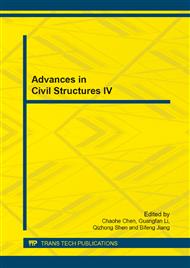p.1129
p.1134
p.1138
p.1145
p.1149
p.1153
p.1157
p.1161
p.1170
Acoustic Emission in Protected and Non-Protected Concrete During the First 24 Hours
Abstract:
Concrete is a composite construction material frequently used in civil engineering. We know that concrete is as a man – when concrete is made it is as a baby, then it ages and its properties change in accordance to its baby life. That means it is better to monitor and change its properties when it is young as soon as possible. However, using the methods immediately after concrete birth (making the mixture) is difficult. Article describes monitoring concrete structure during the first 24 hours from their making. Acoustic Emission Method and the measurement temperature were used for monitoring both samples.
Info:
Periodical:
Pages:
1149-1152
Citation:
Online since:
July 2014
Authors:
Keywords:
Price:
Сopyright:
© 2014 Trans Tech Publications Ltd. All Rights Reserved
Share:
Citation:


